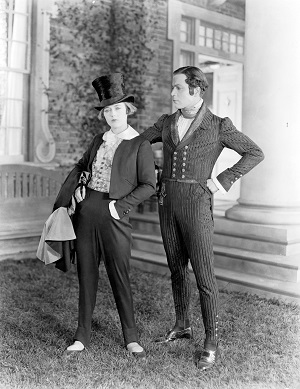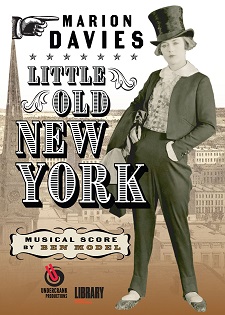
By Thomas Gladysz.
I rejoice in this opportunity to record something which today is all but forgotten except for those lucky enough to have seen a few of her pictures: Marion Davies was one of the most delightfully accomplished comediennes in the whole history of the screen. She would have been a star if Hearst had never happened. –Orson Welles
Welles, of course, is referring to William Randolph Hearst, the newspaper publisher whose epic life was the inspiration behind the director’s classic film, Citizen Kane. And yet, Welles’ statement, which concludes his foreword to Davies’ posthumous memoir, The Times We Had (1977), is illuminating and even revealing about the woman in question.
Early on, Hearst had taken over management of Davies’ career, steering her from unknown chorus girl to film superstar. At the time, he was married and a well known media mogul, an influential billionaire businessman with political ambitions. As is now well known, Davies became Hearst’s longtime mistress. Their relationship – something of an open secret at the time – lasted for decades until Hearst’s death in 1951.
The two had met in the late 1910s, after Davies had appeared in several Broadway musicals and a film which she herself wrote, Runaway Romany (1917). Hearst directed her career, financing her pictures and heavily promoting her through his many prominent newspapers and magazines. He even founded a studio, Cosmopolitan Productions, to produce her films. Over the next two decades, Davies appeared in 29 silent and 17 sound films with the company, which was distributed by Paramount, and later Metro / MGM. Arguably, she was one of the more popular stars of her time. “Hearst put up the money for many of the movies in which Marion Davies was starred” Welles also wrote,
and, more importantly, backed her with publicity. But this was less a favor than might appear. That vast publicity machine was all too visible; and finally, instead of helping, it cast a shadow — a shadow of doubt. Could the star have existed without the machine? The question darkened an otherwise brilliant career.
Davies’ reputation took a big hit in the wake of Citizen Kane (1941). In Welles’ film, Kane’s second wife — a talentless singer who Kane vainly tries to promote — was said by some to be based on the actress. It wasn’t true; nevertheless, an assumed likeness between Davies and the famous film’s pathetic character proved corrosive.
Davies had retired from the screen four years earlier, in 1937. With the Kane characterization in the air, and with the lingering notion of her success having come about through Hearst’s patronage, many wondered if Davies was little more than another instance of Jazz Age excess, or Hollywood ballywho. In a self-deprecating mood, Davies herself once quipped, “With me, it was 5% talent and 95% publicity.”
In the years that followed, what also hurt Davies’ reputation was the fact her films were largely unavailable. Most went unseen for decades. Some were lost, while others languished in film vaults. A couple – like The Patsy (1928) and Show People (1928) – were occasionally shown on television, or at revival houses or film festivals, but most were not. For a long time, anyone with an interest in the actress had to content themselves with picking through whatever film histories referenced her.
That situation is changing, thanks to a group of dedicated individuals who have written articles and books, gotten Davies’ work shown at festivals and on television, and overseen the release of her films on DVD. One of those individuals is Edward Lorusso, the author of The Silent Films of Marion Davies (2017), and the co-producer behind a handful of recent DVDs.
 Lorusso’s latest effort is Little Old New York (1923). Following a successful Kickstarter campaign, Lorusso and musician Ben Model co-produced a DVD released by Model’s ambitious boutique label, Undercrank Productions. This new DVD presents the film in a new 2K digital scan made from Davies’ own 35mm nitrate print preserved at the Library of Congress; the DVD features a fine theatre organ score by Model, one of the leading silent film accompanists working today.
Lorusso’s latest effort is Little Old New York (1923). Following a successful Kickstarter campaign, Lorusso and musician Ben Model co-produced a DVD released by Model’s ambitious boutique label, Undercrank Productions. This new DVD presents the film in a new 2K digital scan made from Davies’ own 35mm nitrate print preserved at the Library of Congress; the DVD features a fine theatre organ score by Model, one of the leading silent film accompanists working today.
Undercrank has a co-branding agreement with the Library of Congress, and to date, has released three long-unseen Davies films preserved by the L.O.C. – When Knighthood Was in Flower, The Bride’s Play, and Beauty’s Worth. Each date from 1922. The just released Little Old New York was yet another in a string of hits for the actress. In fact, Screenland magazine named it the #3 box-office hit of 1923.
Despite the fact Davies was her best as a light, sometimes screwball, comedian, Hearst wanted her to be taken seriously, and he too often pointed her career in the direction of costume dramas and historical epics. The resulting films, especially earlier in her career, didn’t always click. But when they did, they did in a significant way.
When Knighthood Was in Flower was Davies’ first smash hit. A lavish production, Hearst spent an additional million dollars on advertising, with the result being that one New York theatre reported it was sold out eight weeks in advance. (In the silent era, most all films – no matter how popular – typically ran for only a week or two in the bigger cities.) In 1924, Screenland announced the winners of its reader’s poll of the best films ever made; When Knighthood Was in Flower placed a respectable tenth.
Besides being her first smash hit, When Knighthood Was in Flower marked another first in Davies’ career. It was the first film in which she masqueraded as a boy. Davies did so again in Little Old New York. In it, she plays Patricia O’Day, an Irish immigrant in the early 1800s who poses as her younger brother Patrick in order to claim a family inheritance. Another lavishly produced period piece, the film features a number of historical figures, including steamboat inventor Robert Fulton. Harrison Ford (the leading man of the 1920s, not a time travelling Indiana Jones) plays Larry Delavan, a man about town who expects to use the inheritance money to invest in Fulton’s new boat. Complicating things, not to mention gender roles, is Patricia’s falling in love with Delavan, who believes she is actually Patrick!
Davies, always an attractive actress, plays a young man as convincingly as Louise Brooks did in Beggars of Life — that is, if one suspends one’s disbelief and gets into the spirit of things. Which isn’t hard to do because of Davies effectiveness; she possesses an appealing screen presence which transcends this sometimes hokey material.
In the film, Davies’ character is called “an impossible boy.” In Little Old New York, business deals, tailored clothes, smoking, drinking, and carousing define what it means to be a man. And so does taking it like a man. The film’s big gender reveal comes when Davies, as Patrick O’Day, is to be punished for having rung a fire bell. During an energetic though delicately shot scene at the town’s whipping post, the character’s shirt is torn off her back, briefly exposing her welts. Davies’ character screams out, “Stop! For the love of heaven, stop! I’m a girl.” The bare-chested man whipping her is surprised… and, viewer’s sense, even a little pleased. Patricia’s shoulders are barred, but she conceals her breasts. The assembled throng who turned out for the whipping breaks out into a riot. And Davies’ character is rescued by Delavan.
Now referred to as Pat, Delavan states “I hope he will be all right for he’s a game little fellow.” In response, Davies’ character declares, “I am not a game little fellow – I’m just a girl.” And then faints. Delavan, Patricia’s love interest, begins to realize his own affection for the androgynous Pat.
Hearst spared little expense as producer in making Little Old New York. Joseph Urban designed detailed costumes and sets, including an elaborate exterior showing the quaint houses, streets, and waterfront of lower Manhattan, or “little old New York.” Hearst also had an exact replica built of Fulton’s steamboat. Besides Davies and Ford, the cast includes familiars like J. M. Kerrigan, Louis Wolheim, and Harry Watson, Jr. Each help fill out the story.
At that time in film history, upset to the moral order could not stand. At the end of Little Old New York, a council of city elders, all men, sit in judgment of Patricia having impersonated Patrick, her deceased brother. The film reveals it was something she didn’t want to do, but only did at the insistence of her father, who declared he would not be cheated out of the inheritance. Her father even made her take an oath. For impersonating a male, Patricia is fined by the council, but rather ambiguously, these same city elders declare they will pay the fine themselves. Is this justice served, or some small advance in feminist understanding?
If Little Old New York were a contemporary film with a historical setting, things might have ended there. But as it is nearly 100 years old, everything is buttoned up tight. Patricia soon appears in the most lacey, feminine dress imaginable, and Delavan asks her to marry, or as he puts it, become “the little wife of the master of the house.”
Like her contemporaries Clara Bow, Colleen Moore, and Pola Negri, Davies is an actor whose reputation has suffered through no reel fault of her own. Relative to her past fame – and despite the fact she was a gifted comedian who appeared in a string of popular films, Davies is too little regarded today.
Davies was her best in comedies with a contemporary setting, like The Patsy and Show People. Her period pieces and costumes dramas, however, still have considerable charm, largely due to her exuberant personality. If you’re interested in checking out this singular actress, track down any of the above mentioned movies, or Hugh Neely’s excellent 2002 documentary Captured on Film – The True Story of Marion Davies, narrated by Charlize Theron. Lorusso’s The Silent Films of Marion Davies is recommended, as is Davies’ own memoir The Times We Had, with its apologetic foreword by Orson Welles.
Thomas Gladysz writes about early film. He is the author/editor of four books, including Beggars of Life: A Companion to the 1928 Film and Louise Brooks, the Persistent Star. In 2019, he delivered the keynote address at the 92nd Rudolph Valentino Memorial in Hollywood. Due out in 2020 is a two volume work, Around the World with Louise Brooks.
Read also:
The Cinematic Culture of Conspicuous Consumption – When Knighthood was in Flower (1922)
